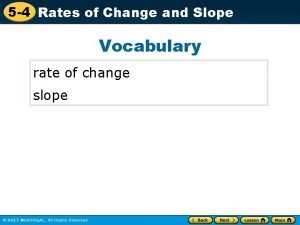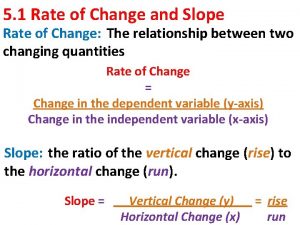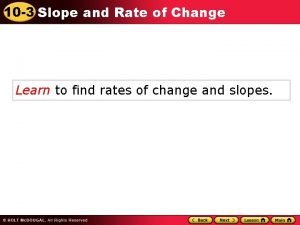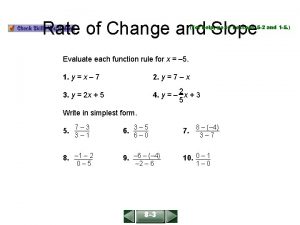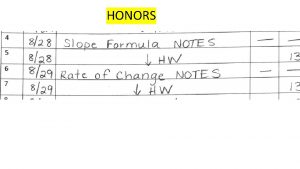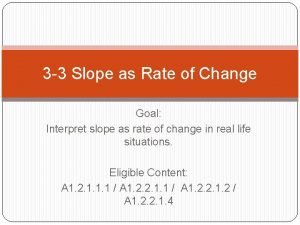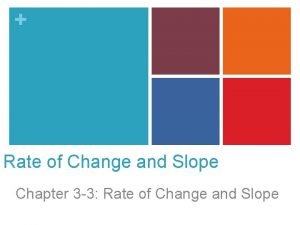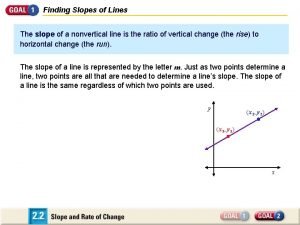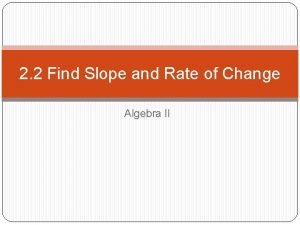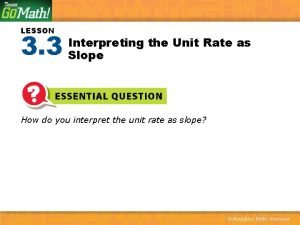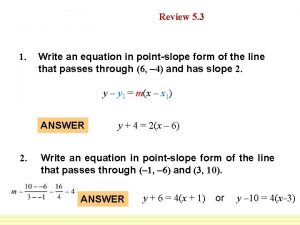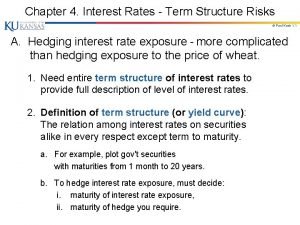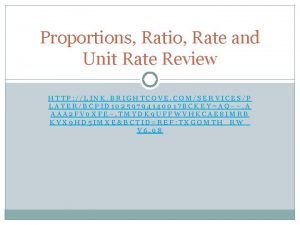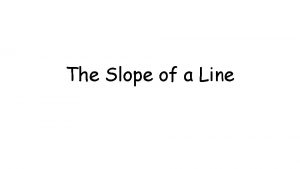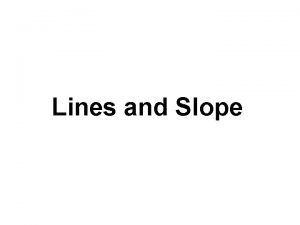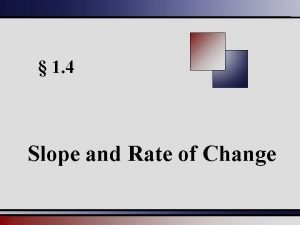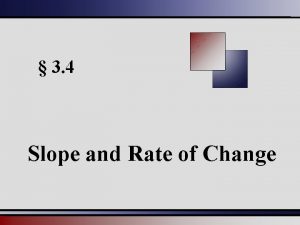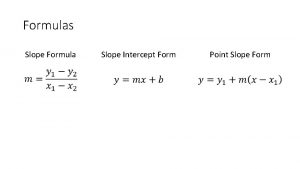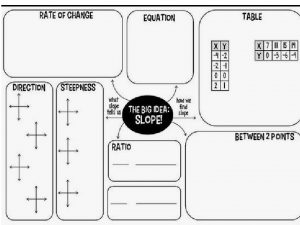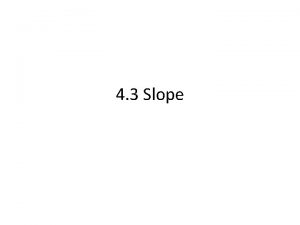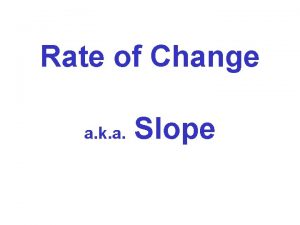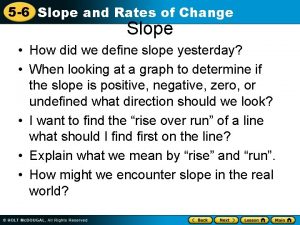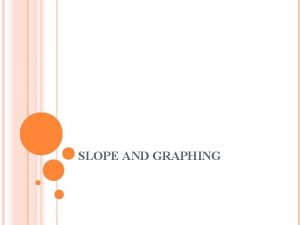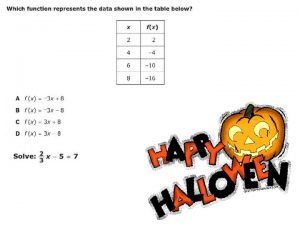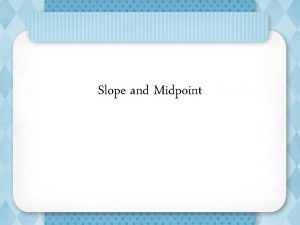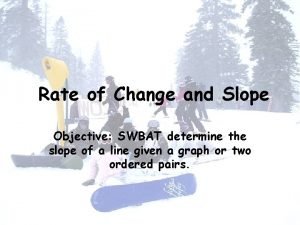Rate of Change and Slope Rate of Change
































- Slides: 32

Rate of Change and Slope Rate of Change: The relationship between two changing quantities Rate of Change = Change in the dependent variable (y-axis) Change in the independent variable (x-axis) Slope: the ratio of the vertical change (rise) to the horizontal change (run). Slope = Vertical Change (y) Horizontal Change (x) = rise run

Real World:

Rate of Change can be presented in many forms such as: We can use the concept of change to solve the cable problem by using two sets of given data, for example: A band practices their march for the parade over time as follows:

Choosing the data from: Time and Distance 1 min 260 ft. 2 min 520 ft. We have the following:

Choosing the data from: Time and Distance 1 min 260 ft. 3 min 780 ft. We have the following:

Choosing the data from: Time and Distance 1 min 260 ft. 4 min 1040 ft. We have the following:

NOTE: When we get the same slope, no matter what date points we get, we have a CONSTANT rate of change:

YOU TRY IT: Determine whether the following rate of change is constant in the miles per gallon of a car. Gallons Miles 1 28 3 84 5 140 7 196

Choosing the data from: Gallons and Miles 1 g 28 m 3 g 84 m We have the following:

Choosing the data from: Gallons and Miles 1 g 28 m. 5 g 140 m. We have the following: THUS: the rate of change is CONSTANT.

Once Again: Real World

Remember: Rate of Change can be presented in many forms: We can use the concept of change to solve the cable problem by using two sets of given data: (x , y) A : Horizontal(x) = 20 Vertical(y) = 30 (20, 30) B : Horizontal(x) = 40 Vertical(y) = 35 (40, 35)

Using the data for A and B and the definition of rate of change we have: (x , y) A : Horizontal = 20 Vertical = 30 (20, 30) B : Horizontal = 40 Vertical = 35 (40, 35)

Using the data for B and C and the definition of rate of change we have: (x , y) B : Horizontal = 40 Vertical = 35 (40, 35) C : Horizontal = 60 Vertical = 60 (60, 60)

Using the data for C and D and the definition of rate of change we have: (x , y) C : Horizontal = 60 Vertical = 60 (60, 60) D : Horizontal = 100 Vertical = 70 (100, 70)

Comparing the slopes of the three: However, we must find all the combination that we can do. Try from A to C, from A to D and from B to C.

Finally: Finally we can conclude that the poles with the steepest path are poles B to C with slope of 5/4.

Class Work: Pages: Workbook Page 97 Home Work/Early Finishers: Textbook Page: 340 Questions: 1 -10

Remember: When we get the same slope, no matter what data points we get, we have a CONSTANT rate of change:

When we get the same slope, no matter what date points we get, we have a CONSTANT rate of change: We further use the concept of CONSTANT slope when we are looking at the graph of a line:

We further use the concept of rise/run to find the slope: run rise Make a right triangle to get from one point to another, that is your slope.

CONSTANT rate of change: due to the fact that a line is has no curves, we use the following formula to find the SLOPE: y 2 -y 1 x 2 -x 1 B(x 2, y 2) A(x 1, y 1) A = (1, -1) B = (2, 1)

YOU TRY: Find the slope of the line:

YOU TRY (solution): -4 (0, 4) (2, 0) 2

YOU TRY IT: Provide the slope of the line that passes through the points A(1, 3) and B(5, 5):

YOU TRY IT: (Solution) Using the given data A(1, 3) and B(5, 5) and the definition of rate of change we have: A( 1 , 3 ) B(5 , 5) (x 1, y 1) (x 2, y 2)

YOU TRY: Find the slope of the line:

YOU TRY IT: (Solution) Choosing two points say: A(-5, 3) and B(1, 5) and the definition of rate of change (slope) we have: A( -2 , 3 ) B(1 , 3) (x 1, y 1) (x 2, y 2)

YOU TRY: Find the slope of the line:

YOU TRY IT: (Solution) Choosing two points say: A(-1, 2) and B(-1, -1) and the definition of rate of change (slope) we have: A( -1 , 2 ) B(-1 , -1) (x 1, y 1) (x 2, y 2) We can never divide by Zero thus our slope = UNDEFINED.

THEREFORE: Horizontal ( slope of ZERO ) lines have a While vertical ( ) lines have an UNDEFINED slope.

VIDEOS: Graphs https: //www. khanacademy. org/math/algebra/line ar-equations-and-inequalitie/slope-andintercepts/v/slope-and-rate-of-change
 Variable rate of change
Variable rate of change How to find rate of change on a graph
How to find rate of change on a graph 5-1 rate of change and slope
5-1 rate of change and slope 3-3 practice rate of change and slope
3-3 practice rate of change and slope 5-1 practice rate of change and slope
5-1 practice rate of change and slope 3-3 rate of change and slope
3-3 rate of change and slope Unit 6 lesson 1 rate of change and slope
Unit 6 lesson 1 rate of change and slope Is the slope the rate of change
Is the slope the rate of change Rate of change of a function
Rate of change of a function 3-3 rate of change and slope
3-3 rate of change and slope Lesson 3 skills practice constant rate of change and slope
Lesson 3 skills practice constant rate of change and slope The difference between slope decline and slope retreat
The difference between slope decline and slope retreat Converting point slope to slope intercept
Converting point slope to slope intercept Slope review classifying slope
Slope review classifying slope Slope review classifying slope
Slope review classifying slope Lesson 3-3 interpreting the unit rate as slope
Lesson 3-3 interpreting the unit rate as slope How to change standard form to slope intercept form
How to change standard form to slope intercept form Converting linear equations
Converting linear equations Standard form of a line quiz
Standard form of a line quiz Cct diagram for hypoeutectoid steel
Cct diagram for hypoeutectoid steel Real vs nominal interest rate
Real vs nominal interest rate Plant growth analysis
Plant growth analysis Yield to worst
Yield to worst 1 year forward rate formula
1 year forward rate formula Difference between rate and unit rate
Difference between rate and unit rate Chemical change meaning
Chemical change meaning Absolute change and relative change formula
Absolute change and relative change formula Difference between chemical and physical property
Difference between chemical and physical property Change in supply and change in quantity supplied
Change in supply and change in quantity supplied What is example of physical change
What is example of physical change Rocks change due to temperature and pressure change
Rocks change due to temperature and pressure change Whats the difference between physical and chemical change
Whats the difference between physical and chemical change First order change adalah
First order change adalah
